Global LED lighting demand is expected to grow sharply in 2014
After three years of cold winter, the LED industry seems to be springing up next year. Foreign UBS Securities pointed out that in 2014, global LED lighting demand will increase by 60%, among which home lighting will grow the most, and will increase by 90% next year. It is estimated that LED chip demand will grow by 25% next year.
2010 is the peak of the LED industry. At that time, the domestic epitaxial faucet factory Jingdian earned more than half of its annual share capital, and the net profit per share (EPS) was 7 yuan (NTD, the same below); the packaging and brand factory billion light also reached 5.52. yuan. However, after China's LED production capacity was opened, Taiwan's factory profits were greatly reduced. In the coming year, Jingdian dropped from the cloud to the world. In 2011, EPS was only 0.5 yuan, and in 2012, it lost more than 1 yuan per share. In the past two years, Yiguang relied on cost. Control, although not losing money, but EPS is also cut half by year.
LEDs will have a three-year low in the bottom of the market next year. The LED industry prospects in the next year seem to be improving. The main kinetic energy comes from lighting, and the growth of backlight demand for tablet computers cannot be ignored. In the latest LED industry analysis report, foreign-funded UBS Securities pointed out that if the chip area is calculated, the demand for LED general lighting will increase by 62% in the next year. If the normal annual unit price falls, the LED lighting revenue growth in the next year will be about 37%. In other words, LED lighting penetration will grow from only 3-5% this year to 9% next year, while traditional incandescent lamps will be reduced by 5% per year.
Light bulb price cuts increase penetration UBS pointed out that US LED giant CREE will launch a 9.5-watt LED bulb (replace 60-watt incandescent bulb) this year, retailing for only $9.97; more importantly, the bulb has passed the US ENERGY STAR certification can receive a $5 per grant, which means consumers can buy it for $4.97, which is equivalent to the price of a light bulb (about $2-5). UBS believes that this means that LED bulbs may have reached a sweet spot.
International big-chip chips are also outsourcing. UBS pointed out that in the lighting market, the penetration rate of household lighting is the lowest. That is because the price of LED bulbs in the past is too high, and it often takes several years for home replacement to be recycled, but the situation will change now. As LED bulbs cut prices, governments have successively banned incandescent lamps (see table), coupled with the global economic recovery, will fuel LED lighting fermentation. UBS estimates that global LED lighting revenue for home lighting will grow by 90% next year, much higher than 37% for commercial use and 57% for industrial use.
International lighting manufacturers such as Philips and OSRAM have only outsourced downstream packaging modules. UBS analyst Fredric Stahl believes that due to the surge in demand for LED lighting next year, big companies are considering adopting Asian LED chips on the upstream side to increase price competitiveness. The industry believes that domestic epitaxial faucet crystal power should be able to benefit.
As for the backlight market, the kinetic energy from TV has been declining year by year. UBS pointed out that although the penetration rate of LED TVs has increased from 75% last year to 95% this year, the number of chips used in each TV has been reduced by 25% (due to the reduction in the number of direct-type TVs). Fortunately, there has been a slight improvement next year, mainly due to the larger TV size and higher resolution of high-resolution TVs such as 4K2K (higher backlight brightness required). UBS estimates that TV's share of LED chips will fall from about 36% this year to 16% and 13% in the next year.
The LED demand for tablet PCs will increase by 90% next year, mainly due to the purchase of Apple iPad, coupled with improved resolution and tablet PCs are still in the growth stage. UBS estimates that demand for LED chips will reach 24% next year.
Xinxiang SKF Machinery Co., Ltd. carrier plates are used for loading the Dressing Grinding Wheel and parts when the grinding machine or lapping machine or polishing machine is running.
Xinxiang SKF Machinery Co., Ltd. supply various types of carrier plate material for different parts and size, imported epoxy plate, imported blue steel, pvc plate, etc.

Carrier Plate,Dressing Stone C Arrier,Green Carbide Stone Carrier,Carbide Dressing Stone Carrier
Xinxiang SKF machinery Co., Ltd. , https://www.grindingmachine.nl